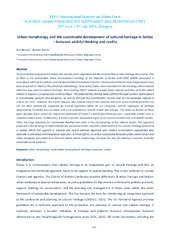Prikaz osnovnih podataka o dokumentu
Urban morphology and the sustainable development of cultural heritage in Serbia – between wishful thinking and reality
| dc.creator | Niković, Ana | |
| dc.creator | Manić, Božidar | |
| dc.date.accessioned | 2022-10-26T08:07:25Z | |
| dc.date.available | 2022-10-26T08:07:25Z | |
| dc.date.issued | 2022 | |
| dc.identifier.isbn | 978-1-914241-16-1 | |
| dc.identifier.uri | http://raumplan.iaus.ac.rs/handle/123456789/653 | |
| dc.description.abstract | The formal planning system in Serbia has recently been upgraded with the introduction of new strategic documents. One of them is the Sustainable Urban Development Strategy of the Republic of Serbia until 2030 (2019) developed in accordance with the EU policies and UN Sustainable Development Goal 11. Multisectoral and territorial approaches have been proposed to improve the planning methodology. Several key topics were considered in the Strategy, where special attention was paid to cultural heritage. The resulting SWOT analysis showed great cultural potential of Serbia which relates to regional, European and world heritage. This potential has already been affirmed through Serbia's participation in international projects and programs, as well as through the proclamation of Novi Sad for the European Capital of Culture for 2021. However, the SWOT analysis also showed that at the national and local levels cultural potential has still not been adequately supported by current legislative which do not recognizes specific typologies of heritage (proposed by ICOMOS) such as urban and rural settlements, historic towns and villages. This leads to decline of these types of urban forms which are important landmarks of Serbia's cultural and historical past – especially smaller ones in underdeveloped areas. Furthemore, it leads to decline of valuable types of vernacular architecture and spatial entities. There are huge pressures for inadequate development even in the surroundings of the cultural assets. The approach proposed in the Strategy sought to bridge the gap between the regulatory framework of the cultural heritage protection in Serbia, which still supports a sectoral and object-oriented approach and modern conservation approaches that advocate a contextual and integrative approach. In these efforts, an active relationship between urban conservation and urban designing and planning is required where urban morphology can pave the way for making a common scientific and professional platform. | sr |
| dc.language.iso | sr | sr |
| dc.publisher | Glasgow : University of Strathclyde Publishing | sr |
| dc.relation | info:eu-repo/grantAgreement/MESTD/inst-2020/200006/RS// | sr |
| dc.rights | openAccess | sr |
| dc.rights.uri | https://creativecommons.org/licenses/by/4.0/ | |
| dc.source | Annual Conference Proceedings of the XXVIII International Seminar on Urban Form. Urban Form and the Sustainable and Prosperous City (ISUF 2021), Glasgow, Scotland, 29 June - 3 July 2021 | sr |
| dc.subject | urban morphology | sr |
| dc.subject | sustainable development | sr |
| dc.subject | heritage | sr |
| dc.subject | planning | sr |
| dc.subject | Serbia | sr |
| dc.title | Urban morphology and the sustainable development of cultural heritage in Serbia – between wishful thinking and reality | sr |
| dc.type | conferenceObject | sr |
| dc.rights.license | BY | sr |
| dc.citation.spage | 1663 | |
| dc.citation.epage | 1672 | |
| dc.citation.rank | M33 | |
| dc.identifier.doi | 10.17868/strath.00080531 | |
| dc.identifier.fulltext | http://raumplan.iaus.ac.rs/bitstream/id/2765/Nikovic_Manic_ISUF_2021_Urban_morphology_and_the_sustainable_development_of_cultural_heritage.pdf | |
| dc.type.version | publishedVersion | sr |

